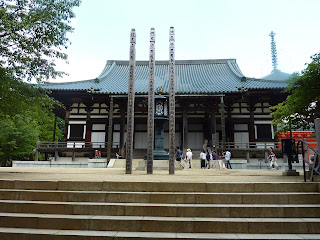Southeast of Osaka is the religious retreat of Koyasan, tucked in a basin about 1,000 meters above sea level and surrounded by forested mountain peaks. Originally founded in 816 A.D., and devoted to the Shingon Sect of Buddhism, there are now over 100 temples and sub-temples in the region. Some temples accept guests, and we stayed at the Kondo-mae temple. A few temple photos:
The stay included an excellent vegetarian dinner and breakfast, and the opportunity to listen to the lyrical chanting of the monks during the morning service. Meals are prepared Shojin Ryori style, which originated in China, and consists of five flavors, five cooking methods, and five colors. Each meal should include a grilled dish, a deep-fried dish, a pickled dish, a tofu dish, and soup.

My room at the temple
Beautifully presented dinner
The Koyasan Reihokan museum is a good place to begin a visit of the area as it displays numerous artworks and implements that are important in Shigon Buddhism. Nearby is the Danjo Garan complex with the striking Konpondaito Pagoda, nearly 50 meters tall.
Also impressive is the Kongobuji Temple, with beautiful painted sliding doors and the largest rock garden in Japan.
Perhaps the most interesting site, however, is the Okunoin cemetery, with more than 200,000 tombs flanked by a mountainside and nestled among cedar trees. At one end of the cemetery is the mausoleum of Kobo Daishi, the founder of Koyasan.






















































